Original title: Looking back at the Guangdong epidemic in January: 70% of confirmed cases came from close contact, and the elderly accounted for 30%
Source: Southern Weekend
As of 24:00 on June 20, Guangdong has reported a total of 168 confirmed cases of local new crown pneumonia in this round of epidemics, which are basically concentrated in two transmission chains in Guangzhou and Shenzhen: one from Liwan, Guangzhou to Foshan, Maoming, Zhanjiang and other places, and the other From Shenzhen to Dongguan. The results of viral genetic testing confirmed that both chains of transmission originated from overseas imports.
Wen|Wang Yachun
On May 21, 2021, Liwan District of Guangzhou City notified a confirmed case of local new crown pneumonia, and the Liwan District New Crown Pneumonia Prevention and Control Headquarters immediately activated the epidemic handling mechanism. On the same day, a case of asymptomatic infection of the native new crown virus was found in Yantian District, Shenzhen. A new round of epidemic prevention and control war has started in Guangdong.
A month has passed. As of 24:00 on June 20, Guangdong has reported a total of 168 confirmed cases of new coronary pneumonia in Guangdong, including 146 in Guangzhou, 7 in Shenzhen, 12 in Foshan, 2 in Dongguan, and 1 in Zhanjiang. The current round of the epidemic in Guangdong is basically concentrated in two transmission chains: Guangzhou and Shenzhen: one is from Guangzhou Liwan to Foshan, Maoming, Zhanjiang and other places, and the other is from Shenzhen to Dongguan.
 (From May 21 to June 20, 2021, the distribution of confirmed cases of new coronary pneumonia in Guangdong. Liang Shuyi/graphic)
(From May 21 to June 20, 2021, the distribution of confirmed cases of new coronary pneumonia in Guangdong. Liang Shuyi/graphic)1
Sui-Shen Communication Chain, all related to overseas
On May 17, Shenzhen’s Mu was operating on an international freighter in Yantian Port. On May 21, during the routine inspection of the boarding operators of Yantian Port International Freighter, Mu was tested as an asymptomatic infected person. Subsequently, the three colleagues working on the same freighter with him were all tested as asymptomatic infected persons, and this round of the Shenzhen epidemic began. The Guangzhou epidemic spreading chain started at “another” teahouse on May 19, where the initial case Guo Mou ate in there on the same day. In the circulation work after she was diagnosed, Song Moumou, who was in the same teahouse, and Song Yao Mou was tested positive one after another, and the epidemic subsequently affected Haizhu District of Guangzhou City, Maoming City of Guangdong Province, Foshan City and other places.
 (Guangzhou and Shenzhen epidemic spread outside the spread chain. Liang Shuyi/Picture)
(Guangzhou and Shenzhen epidemic spread outside the spread chain. Liang Shuyi/Picture)Feng Zijian, a researcher at the China Centers for Disease Control and Prevention, pointed out at a press conference on the Joint Prevention and Control Mechanism of the State Council on June 11 that my country’s current risk is still imported from abroad, and it is still in the normalized prevention and control of “imports from outside and rebounds from inside”. stage. The results of viral genetic testing also confirmed that the two transmission chains in Guangdong and Shenzhen in this round of the epidemic all originated from overseas imports. The Guangzhou epidemic originated from the Delta mutant strain of the new coronavirus that was first discovered in India. The Shenzhen epidemic is related to the Alpha mutant strain (first discovered in the UK) and the Delta mutant strain.
As the “South Gate” of China, Duan Yufei, director of the Guangdong Provincial Health Commission, introduced at a press conference on the Joint Prevention and Control Mechanism of the State Council on May 20 that Guangdong accepts 90% of the country’s total number of immigrants every day. In order to control the work, it is also necessary to properly control the overseas import. According to statistics, since May 21, Guangdong has accumulatively imported 136 confirmed cases overseas.
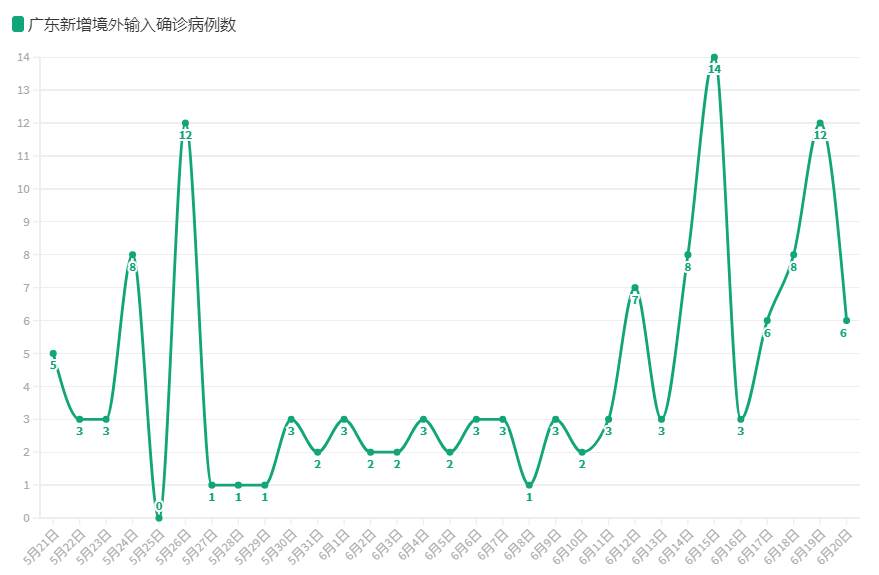 (From May 21 to June 20, 2021, the number of newly imported confirmed cases in Guangdong. Wang Yachun/Tu Meigui/Data compilation)
(From May 21 to June 20, 2021, the number of newly imported confirmed cases in Guangdong. Wang Yachun/Tu Meigui/Data compilation)2
Guangzhou: Fast spread and clear chain
As of June 20, Guangzhou has reported a total of 146 confirmed local cases and 7 asymptomatic infections in this round of the epidemic, plus 12 cases notified by Foshan, 1 case in Zhanjiang, and 1 case of asymptomatic infection in Maoming. There are a total of 167 infected people in the spread chain of the epidemic.
Cases are concentrated and there is a clear chain of transmission
Most of the infected persons in the Guangzhou epidemic transmission chain are concentrated in Guangzhou, and the transmission is mainly in homes or public places. There are no related cases outside the province, and the situation of long-distance transmission in the province is also limited.
Zhang Zhoubin, deputy director of the Guangzhou Center for Disease Control and Prevention, said that the Guangzhou epidemic was mainly spread after being infected in relatively closed places such as co-living, co-dining, co-custody, etc. There is a clear chain of transmission among infected people. Among the 146 cases in Guangzhou, 72% were close contacts or sub-close contacts of previously confirmed cases. Most of the infected people are associated with key areas such as Baihedong Street and Zhongnan Street, and they are scattered in dots.
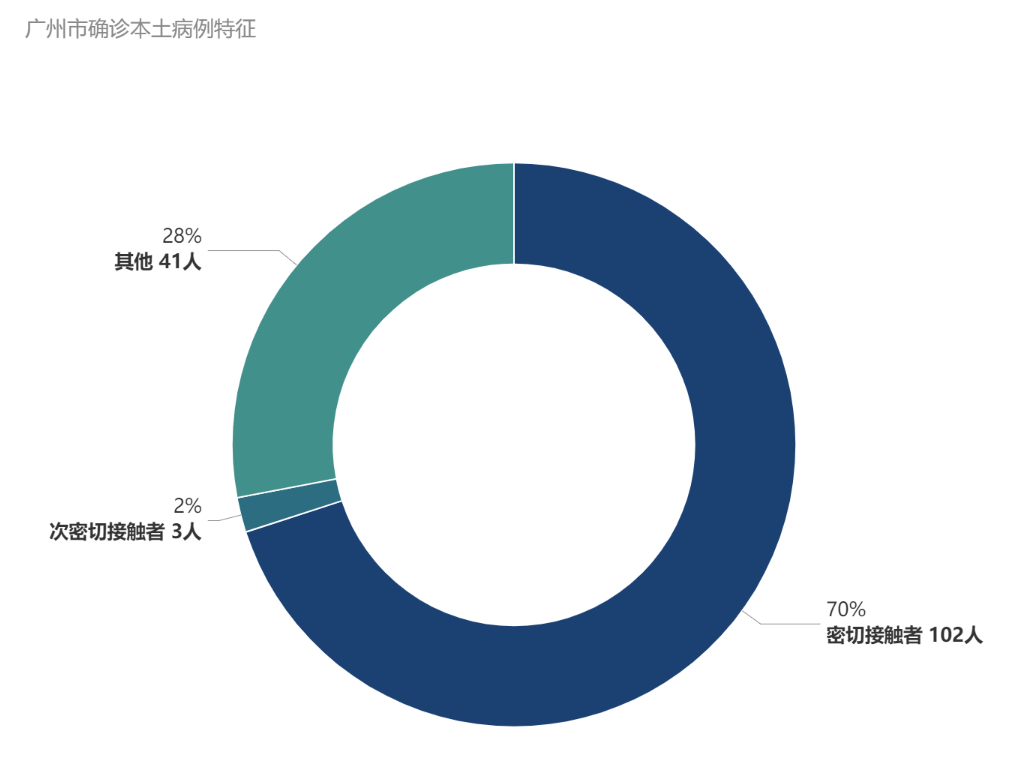 (Characteristics of confirmed cases in this round of the epidemic in Guangzhou. Wang Yachun/Tu Meigui/Data compilation)
(Characteristics of confirmed cases in this round of the epidemic in Guangzhou. Wang Yachun/Tu Meigui/Data compilation)The virus spreads quickly, the disease develops quickly, and the proportion of critically ill patients is high
The Guangzhou epidemic is the first report of community transmission of the Delta mutant strain in China. According to the model prediction, the transmission capacity of the mutant strain is 100% higher than that of the old strain and 50% higher than the previous Alpha mutant strain. Super transmission power and high viral load, coupled with the large number of middle-aged and elderly cases and clusters of cases in Guangzhou, various factors have brought more challenges to the prevention and control of the epidemic.
Among the 146 cases in Guangzhou, the oldest is 92 years old and the youngest is 1 year old. The proportion of patients over 60 years old is nearly 37%. In an interview with Xinhua News Agency, Guan Xiangdong, an expert in the medical treatment team of the Guangdong Working Group of the Integrated Prevention and Control Mechanism of the State Council and director of the Department of Critical Care Medicine of the First Affiliated Hospital of Sun Yat-sen University, said in an interview with Xinhua News Agency that most of the severe patients in the epidemic were elderly people aged 70-90. The high proportion of elderly patients is a factor leading to the rapid development of the disease and the high proportion of critically ill patients.
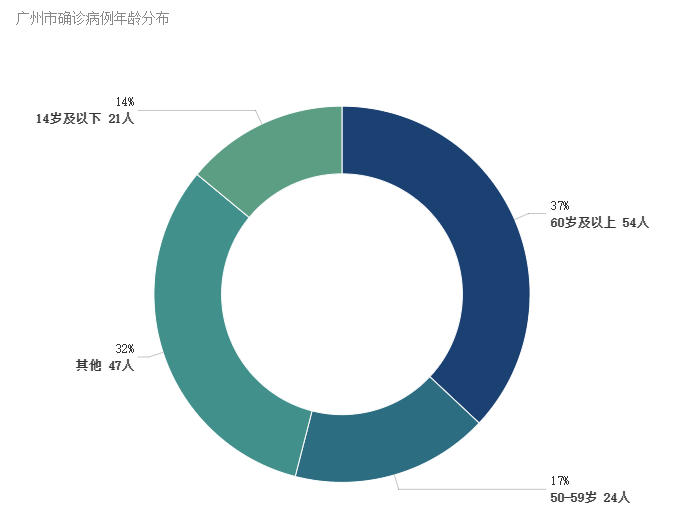 (The age distribution of confirmed cases in this round of the epidemic in Guangzhou. Wang Yachun/Tu Meigui/Data compilation)
(The age distribution of confirmed cases in this round of the epidemic in Guangzhou. Wang Yachun/Tu Meigui/Data compilation)Guan Xiangdong said that in this round of the epidemic, the proportion of patients who became severe and critical after the onset of the disease was higher than before, reaching 10%-12%. More than 12% of the patients required oxygen therapy, and the time of exacerbation was changed from the previous 6-10 days advanced to 3-7 days, which also increased the difficulty of treatment.
Three rounds of large-scale nucleic acid testing and screening, 10.73 million people vaccinated
On May 22, Longhuixin Pavilion, Longjin Street, Liwan District, Guangzhou City, was adjusted to a medium-risk area. Within two weeks, 11 districts in Guangzhou successively carried out nucleic acid screening for all employees, with a total of 27,985,500 samples taken. As of June 20, a total of 10.73 million people had been vaccinated, of which 6.36 million had completed the entire vaccination process.
Through timely adjustment of key areas and multiple rounds of nucleic acid screening, the spread of the virus has been controlled within a limited range, and a large-scale community spread and epidemic has not been formed.
Since May 26, Guangzhou, which has a permanent population of 18 million, has carried out three large-scale nucleic acid screenings for all employees, and several rounds of nucleic acid tests have been carried out in key areas.
After several risk area adjustments, as of June 19, Guangzhou currently has 1 high-risk area (Baihedong Street) and 7 medium-risk areas.
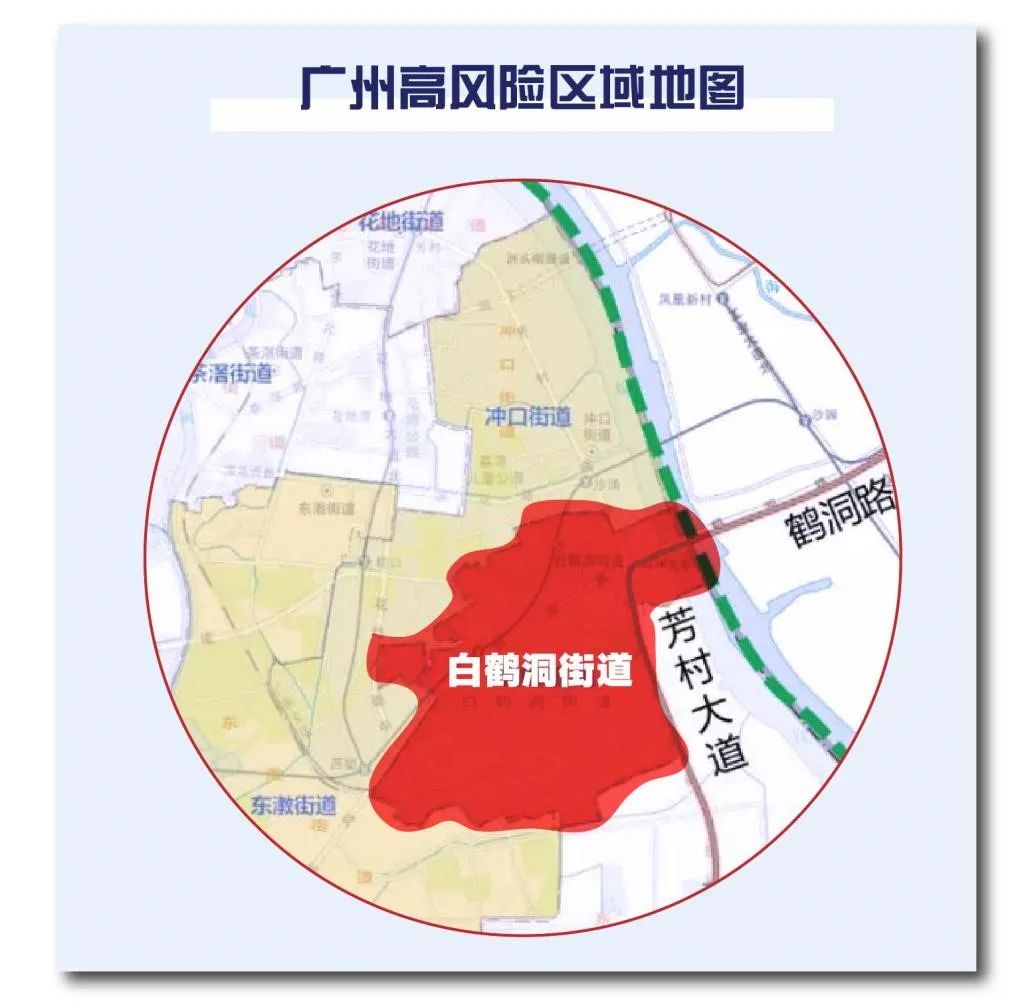 (As of June 19, the distribution map of high-risk areas in Guangzhou. Liang Shuyi/Picture)
(As of June 19, the distribution map of high-risk areas in Guangzhou. Liang Shuyi/Picture)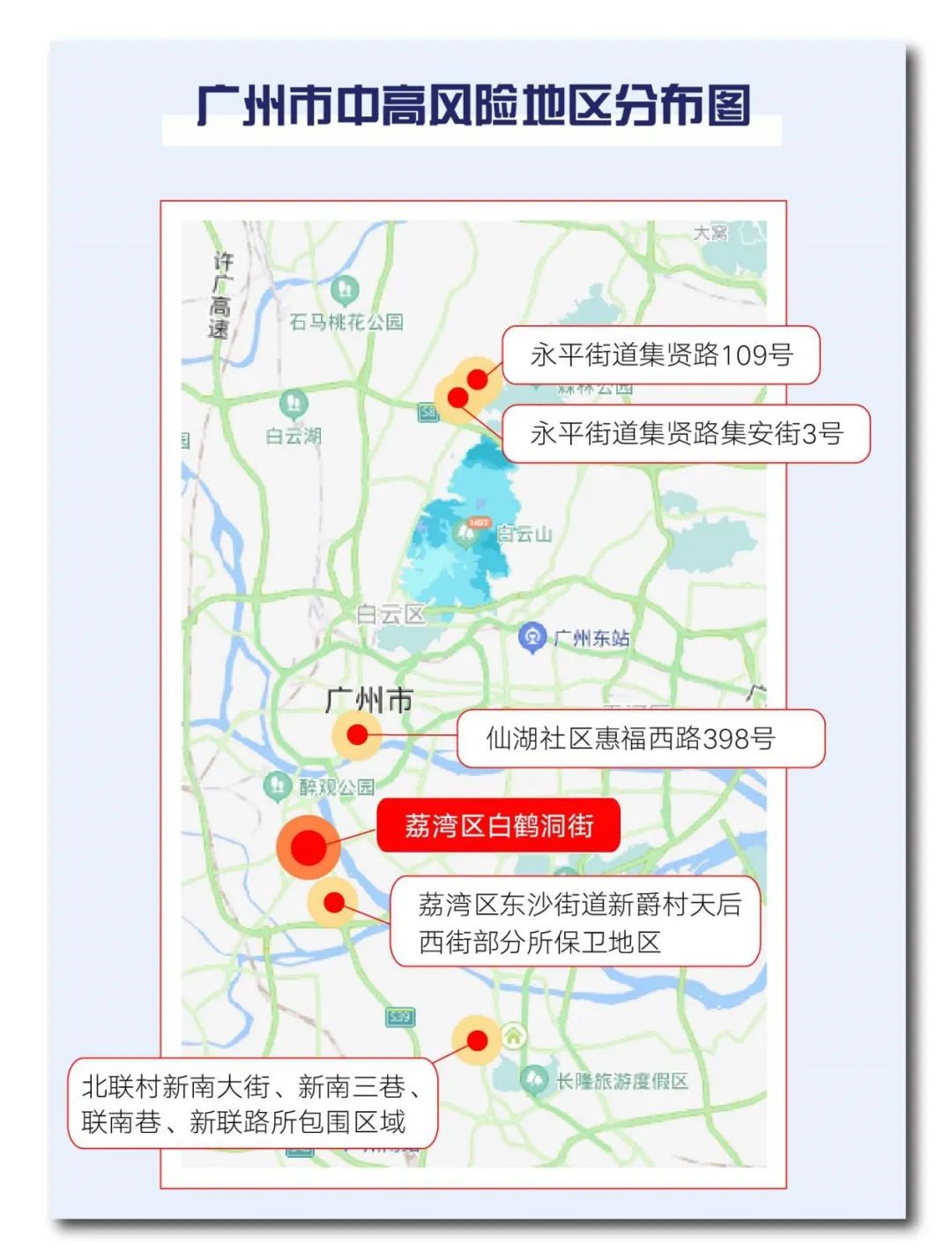 (As of June 19, the distribution map of medium and high risk areas in Guangzhou. Liang Shuyi/Picture)
(As of June 19, the distribution map of medium and high risk areas in Guangzhou. Liang Shuyi/Picture)In one month, Guangzhou experienced three peaks of newly diagnosed cases every day. After June 10, the number of confirmed cases gradually decreased, and the trend of epidemic prevention and control tended to slow down.
 (From May 21 to June 20, 2021, the number of newly confirmed local cases in Guangzhou. Wang Yachun/Tu Meigui/Data compilation)
(From May 21 to June 20, 2021, the number of newly confirmed local cases in Guangzhou. Wang Yachun/Tu Meigui/Data compilation)3
Foshan and Zhanjiang: The epidemic is under control
The local confirmed cases in Foshan and Zhanjiang are all related to Guangzhou, and the epidemics in the two places are currently under control.
On May 28, Foshan reported a confirmed case of local new coronary pneumonia, which was a close contact with Lei Moumou, an asymptomatic infected person in Guangzhou. On the same day, Foshan carried out a nucleic acid test for all employees in Chancheng District.
As of June 20, Foshan Chancheng and Nanhai districts have carried out nucleic acid testing for all employees, and Guicheng Street, Nanhai District, has two medium-risk districts.
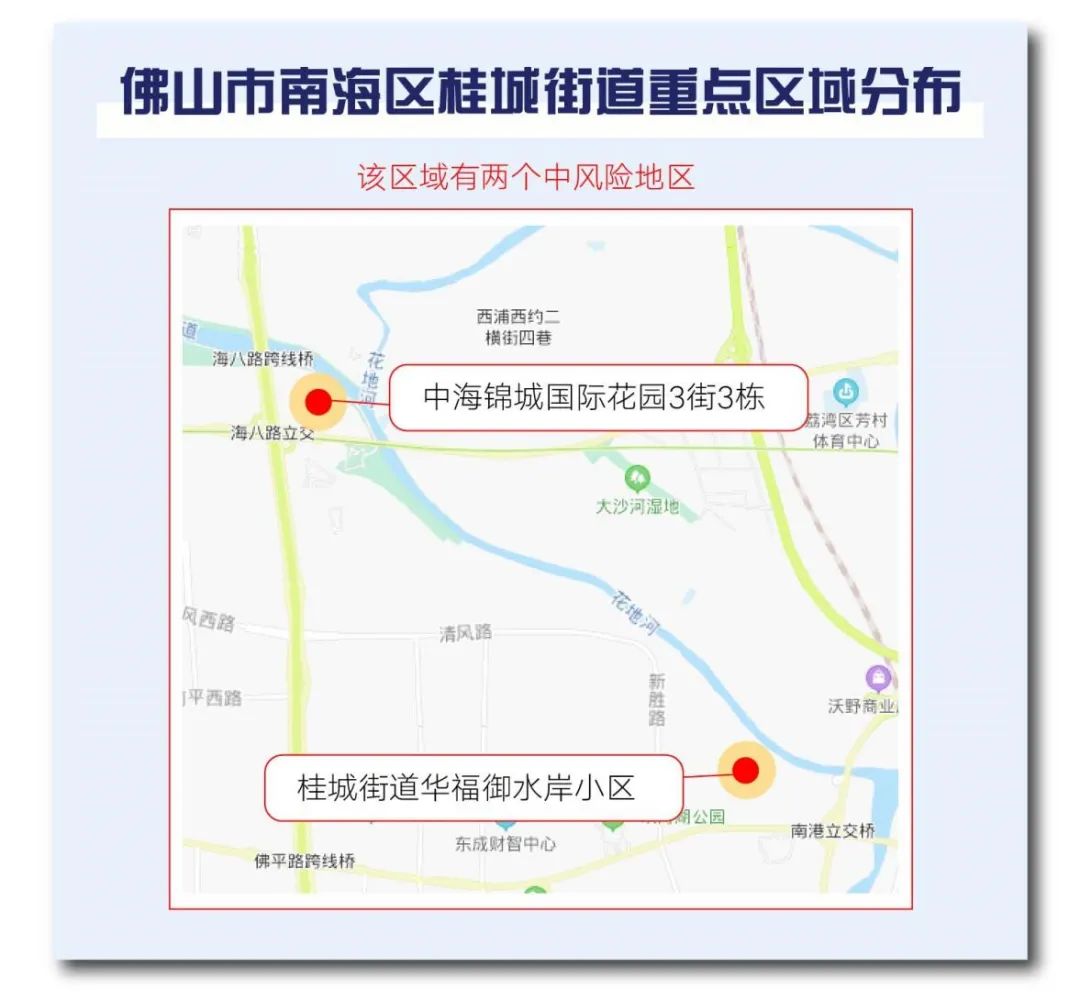 (As of June 20, the distribution map of medium-risk areas in Foshan City. Liang Shuyi/Picture)
(As of June 20, the distribution map of medium-risk areas in Foshan City. Liang Shuyi/Picture)On June 6, Zhanjiang reported that one case of asymptomatic infection was found. The infected person had previously worked in Guangzhou and was diagnosed two days later. Xiarong Village, Qinba Town, Wuchuan City, where the case currently lives, has been adjusted to a medium-risk area, and entertainment venues such as Internet cafes and theaters in Zhanjiang City have been temporarily closed.
4
Shenzhen: mutant strains are coming
Unlike Guangzhou, the spread of the epidemic in Shenzhen is divided into two stages, which are caused by two mutant strains: the Alpha mutant strain first discovered in the United Kingdom and the Delta mutant strain first discovered in India. They passed through the port and The airport enters the territory.
On May 21, Shenzhen Yantian reported 1 case of asymptomatic infection of the new crown virus. In subsequent investigations, Shenzhen successively found 1 confirmed case and 15 cases of asymptomatic infection, all of whom were infected with the Alpha mutant strain.
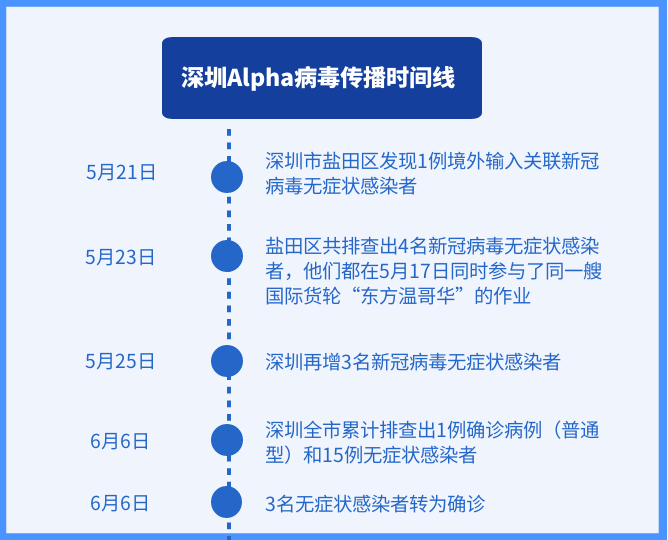 (Shenzhen Alpha virus transmission timeline. Wang Yachun/Picture)
(Shenzhen Alpha virus transmission timeline. Wang Yachun/Picture)One week after the epidemic was under control, on June 14, a confirmed case of new coronary pneumonia was found in Nanshan District, Shenzhen, who was a customs officer at Baoan Airport. The next day, through the epidemiological investigation of the passengers entering the international flight CA868 on June 10, which it was responsible for, the Shenzhen Centers for Disease Control and Prevention completed the 3 cases of imported positive cases reported by the flight and the sequencing of Jiang’s new coronavirus gene. , The results of the 4 cases were 100% homologous, all of which were the Delta mutant strain of the new coronavirus. On the CA868 flight, a total of 32 infected persons were found.
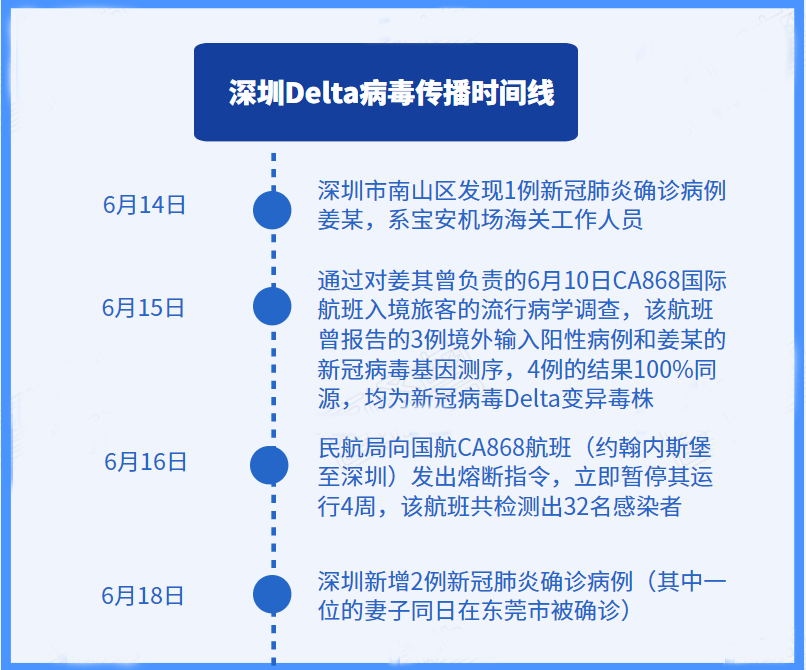 (Shenzhen Delta virus transmission timeline. Wang Yachun/Picture)
(Shenzhen Delta virus transmission timeline. Wang Yachun/Picture)As of June 19, Shenzhen has experienced two overseas imports of new coronavirus variants, with a total of 7 confirmed cases, and both the number of transmissions and the scope of transmission have been effectively controlled.
5
Dongguan: 2 confirmed cases, nucleic acid testing for all employees in the city
On June 18, Dongguan reported a case of Li, a confirmed case of new coronary pneumonia, and this case was in a husband-and-wife relationship with Xiao, who was among the confirmed cases in Shenzhen that day. That night, Dongguan carried out nucleic acid testing and sampling for a total of 2.5 million people in 5 streets, and implemented closed management in 13 key areas.
On June 20, Dongguan added 1 new confirmed case, which was a close connection of the confirmed cases on the 18th. The genetic sequence test showed that the genome sequence of case Li and Xiao were highly consistent, and they were Delta mutant strains, but they were not in the same branch as the genome sequence of the Guangzhou epidemic.
On June 21, in order to prevent the further spread of the epidemic, Dongguan launched a nucleic acid test for all employees in the city.
(The information comes from the websites of the Guangdong Provincial Health Commission and the municipal health departments, Xinhua News Agency, Nanfang+, etc.)
Produced by Southern Weekend All Media Lab
.
